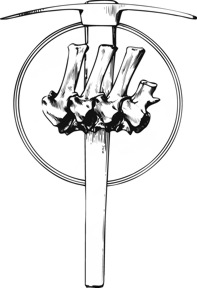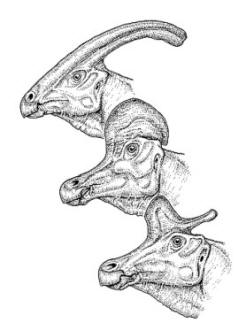- News & information
- About
- History
- George V. Voinovich
- George V. Voinovich Collection
- Calendar
- How to Find Us
- News
- Archives
- Photojournalism Fellowship Project
- Photo Essays
- Current Fellow
- Previous Fellows
- Reports and Publications
- Archives
- Students
- Prospective
- Center for Entrepreneurship
- Environmental Studies
- HTC/Voinovich School Scholars
- Master of Public Administration
- Current
- HTC/Voinovich School Scholars
- Center for Entrepreneurship
- Environmental Studies
- Master of Public Administration
- Alumni
- Contact
- School Leadership
- Strategic Partners Alliance
- Ohio University Public Affairs Advisory Committee
- Ohio University Public Affairs Advisory Committee
- Faculty and Fellows
- Faculty
- Visiting Professors
- Voinovich Fellows
- Professional Staff
| Lawrence M. Witmer,
PhD
|
Brain structure provides the key to
unraveling the function of bizarre dinosaur crests
High-tech imaging reveals inner structure of duck-billed
dinosaur skulls
ATHENS, Ohio (Oct. 9, 2008) — Paleontologists have long debated the function of the strange, bony crests on the heads of the duck-billed dinosaurs known as lambeosaurs. The structures contain incredibly long, convoluted nasal passages that loop up over the tops of their skulls.
Scientists at the University of Toronto, Ohio University and Montana State University now have used CT-scanning to look inside these mysterious crests and reconstruct the brains and nasal cavities of four different lambeosaur species. At the annual meeting of the Society for Vertebrate Paleontology in Cleveland, Ohio, on Oct. 16, the team will present new study findings that suggest the crests were used for communication.
“The shape of the brain can tell us a lot about what senses were important in a dinosaur’s everyday life, and give insight into the function of the crests,” said study lead author David Evans, a paleontologist at the Royal Ontario Museum and the University of Toronto.
Some paleontologists have suggested that the crests heightened the sense of smell by increasing the surface area of the sensory tissue. Others have argued that they regulated temperature, and still others have speculated that the crests acted as sound resonators for communication.
“It’s difficult to infer the function of structures in an extinct dinosaur when there is so little resemblance to any living animal,” said Jack Horner, a member of the team and paleontologist at Montana State University.
By using and analyzing CT scans, conducted by Lawrence Witmer and Ryan Ridgely of Ohio University’s College of Osteopathic Medicine, the scientists were able to circumvent the problems of fossilization.
“Even though the soft tissues are not preserved in the fossils, the shape of the bones that encase the brain and nasal passages are,” said Evans. “From there, the anatomy of these missing soft parts is easily interpreted.”
The CT scan results revealed a mismatch between the external shape of the crest (which no doubt functioned as a visual display) and the internal shape of the nasal passages in closely related species, suggesting a special function for the nasal cavity. The portion of the brain responsible for the sense of smell was relatively small and primitive, indicating that the crest did not evolve to improve that sense.
Computer models done by other researchers suggest that the crests could have been used to make low, eerie bellowing calls that could have been used in communication, perhaps to call for mates or warn others of predators. The CT scans documented a delicate inner ear that confirms that the dinosaurs could hear the low-frequency calls produced by the crest.
“We were surprised to see just how large the centers of the brain associated with higher cognitive functions were,” said Witmer, Chang Professor of Paleontology in Ohio University’s College of Osteopathic Medicine . “We suspected that the crested duck-billed dinosaurs used both vocal and visual displays, but now we see that they had the brain power and hearing to pull off these behaviors.”
When all the available information is put together, including the digital brain and ear casts, the evolutionary relationships of the species, and the growth pattern of the crest and its high degree of variability in different co-existing species, it supports the idea that the elaborate nasal cavity was likely used to produce sounds for communication. This study demonstrates the power of using an integrated approach combining 3D imaging, growth studies, and phylogenetic sampling to test ideas about the function and evolution of unusual structures in extinct animals.
The research was funded by the National Science and Engineering Research Council of Canada and the National Science Foundation. This study also will be published in part in an upcoming issue of the journal The Anatomical Record .
Contact: David Evans can be contacted at: davide@rom.on.ca , Ph: 416-586-5753; Lawrence Witmer can be contacted at witmerL@ohio.edu , Ph: 740-593-9489.
| Download news releases (Word docs) |
|---|
| • Ohio University release
• Society of Vertebrate Paleontology release |
| Animation |
| Animation: Skulls of a
juvenile and subadult Corythosaurus
fade
to reveal the brain and nasal passages within.
The complicated nasal passage within the showy
crest functioned as resonating chambers during
vocalization. The structure of the inner ear and
expanded brain confirms that duck-billed
dinosaurs were capable of perhaps sophisticated
behavioral communication.
|
| Graphics |
| |
| |
| |
• NSF news release: Key to Function of Dinosaur Crests Found in Brain Structure ( download as PDF )
• National Geographic News: Crested Duck-Billed Dinosaurs Used "Caller ID"? ( download as PDF )
• Live Science: Bizarre Dinosaur Headgear Used For Shouting ( download as PDF )
• UPI: Dinosaur head crest function is determined ( download as PDF )
• Discovery News: Duck-Billed Dinosaurs Emitted Low, Eerie Sounds ( download as PDF )
• Cleveland Plain Dealer: Some dinosaurs' flashy crests helped them toot their
horns, scientists now say
( download
as PDF
)
• Ohio University: Brain structure provides key to unraveling function of
bizarre dinosaur crests
( download
as PDF
)
• Russian Academy of Sciences (in Russian): Russian_Academy_of_Sciences_blog_for_kids ( download as PDF )
• Ciência Hoje On-Line (Brazil, in Portuguese): The mystery of the crests of lambeosaurs ( download as PDF )
• Science: Skulls show dinos blew their horns ( download as PDF )
Contact Information:
(740) 593–9381 | Building 21, The Ridges
Ohio University Contact Information:
Ohio University | Athens OH 45701 | 740.593.1000 ADA Compliance | © 2018 Ohio University . All rights reserved.

























